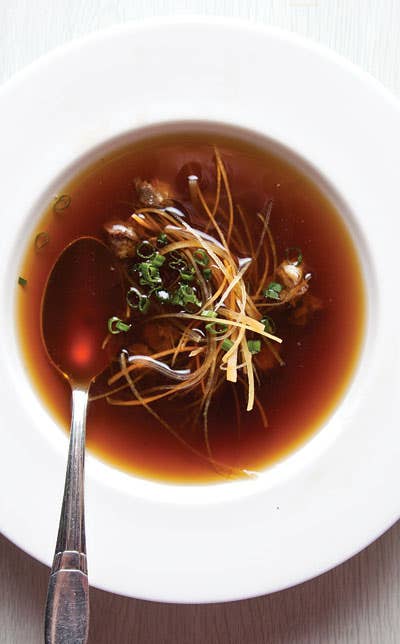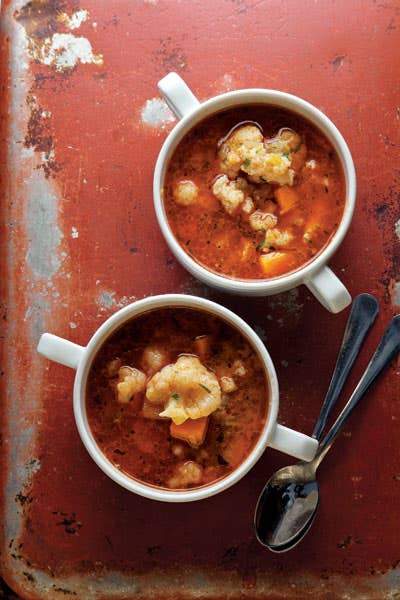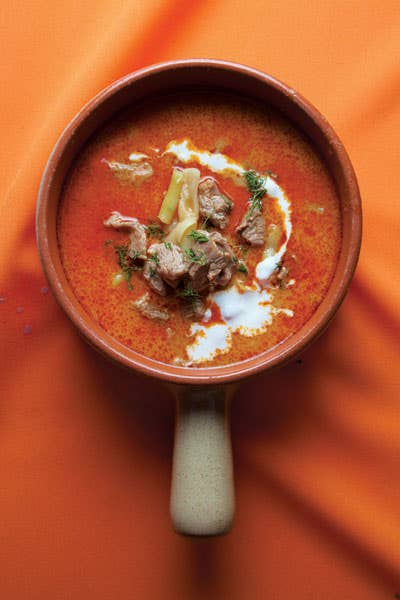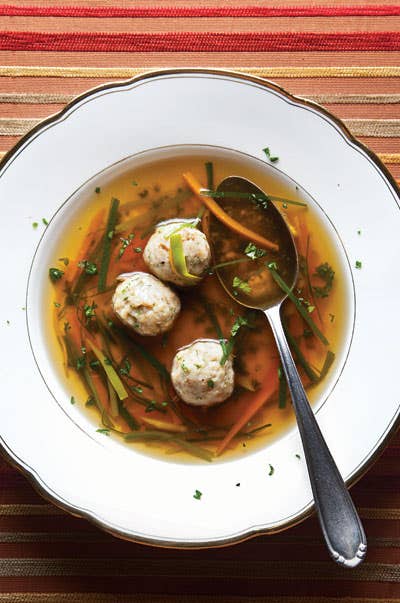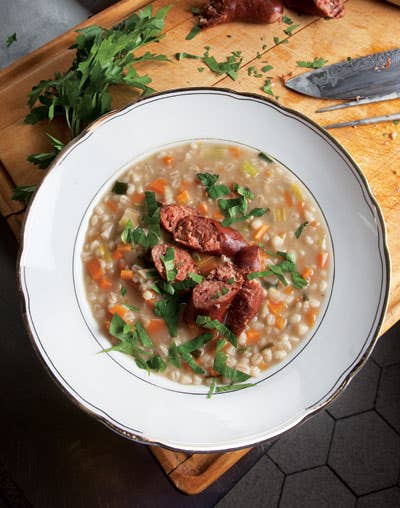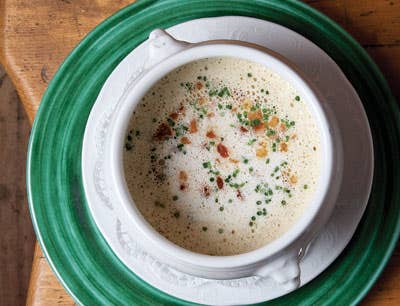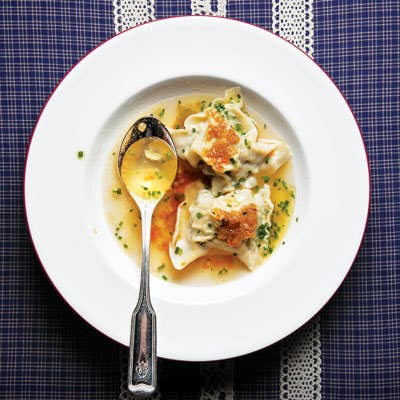
The Art of Soup: Central Europe’s Warmest Traditions
In the heart of Europe, a grand soup-making tradition endures
When there's a chill in the air, few sights are as reassuring as a pot of soup bubbling on the stove top. That's true in much of the world, but the countries of Central Europe have given rise to what is arguably the richest soup-making tradition of all. Dumplings in meaty broth, hearty pottages thick with barley, velvety purees of vegetables and cream: Soups like these run through the region just as surely as the Rhine and Danube rivers do. There are diff erent inflections, of course, depending on where you are: the bonanza of dumplings—from tiny spaetzle to brawny, meat-filled Maultaschen—in southern Germany; the penchant for sour cream closer to the Black Sea; and in Hungary, the vivid red broths spiced with paprika. Over the centuries, these disparate foodways have coalesced into a unified canon, and the soups on the following pages are all shaped by principles of classical technique still rigorously upheld in Mittel-European professional kitchens. Soup is, fundamentally, the most economical of foods, a means of making leftovers and scraps into a satisfying meal. But exquisite soups like these are something more: a testament to the transformative power of passionate and thoughtful cooking. They are as pleasurable to prepare as they are to eat.
[
Maultaschensuppe (Dumplings in Broth)
See the recipe »](https://www.saveur.com/article/recipe/Maultaschensuppe-Dumplings-in-Broth/)
The meat-filled, ravioli-like dumplings in this deeply comforting soup (pictured on the previous page) are a specialty of Swabia, in southern Germany. Their name, Maultaschen, literally means "feedbag," probably because their shape resembles one, though they're also known as Herrgottsbscheiβerle, or "little ones to cheat the Lord," as they're traditionally served on Christian days of fasting—the assumption being that God won't be the wiser as long as the meat is concealed within the pasta. This simple-looking soup is similarly deceptive: Complex flavor is built in at every stage of the cooking process. The base is a chicken stock enhanced with a confetti of brunoise-cut carrots and celery, and garnished with chives. The filling in the dumplings is a savory mix of minced beef, pork, veal, and smoky bacon; egg, cream, spinach, and nutmeg make them even more sumptuous. And a final dollop of caramelized onion on each meaty dumpling provides a hit of concentrated sweetness.
[
Ochsenschwanzsuppe (Oxtail Consommé)
To ensure that this consommé is absolutely clear, a “raft” of ground beef and egg whites is created to absorb impurities, producing an elegant soup with concentrated flavor. See the recipe for Ochsenschwanzsuppe (Oxtail Consommé) »
Photo: Todd Coleman
Ochsenschwanzsuppe (Oxtail Consomme)
See the recipe »](https://www.saveur.com/article/Recipes/Ochsenschwanzsuppe-Oxtail-Consomme/)
Oxtail is a delicious cut, and a particularly useful one for making soup. It contains plenty of collagen and marrow, which contribute rich flavor and luscious body to a consomme—a kind of broth whose name translates as consummate, or perfect, which in this context means perfectly clear. This version comes from northern Switzerland, but similar soups come out of restaurant kitchens across the Continent; it owes its extraordinary depth not only to the oxtail but also to a few time-honored culinary techniques. Pincage, for example, is a French-derived method for caramelizing tomato paste to bring sweetness to the soup without imparting a detectable tomato flavor. The oxtail is roasted to a dark brown before going into the pot, which caramelizes its surface and imparts intense savory flavor as well as sweetness. Perhaps most ingenious of all is what's called a raft: a mass of ground meat and egg whites cooked with the broth to absorb impurities. When the raft is discarded, what's left is a consomme of crystalline clarity.
[
Paprika-Spiced Cauliflower Soup (Karfiolleves)
This recipe for paprika-spiced cauliflower soup comes from chef Andrea Németh at the restaurant Bagolyvár in Budapest. To form the tiny dumplings, called galuska, she simply drops bits of dough into the simmering broth. Get the recipe for Paprika-Spiced Cauliflower Soup (Karfiolleves) »
Photo: Todd Coleman
Karfiolleves (Paprika-Spiced Cauliflower Soup)
See the recipe »](https://www.saveur.com/article/Recipes/Karfiolleves-Paprika-Spiced-Cauliflower-Soup/)
In Hungary, the soup course is a point of national pride, and Hungarian cooks have developed a whole battery of soup-making techniques unknown in other European cooking traditions. One secret behind this warming, brick-red cauliflower soup is the handling of the paprika, a spice introduced by occupying Turks in the 16th century and thereafter embraced by Hungarians as their own. Paprika is fat-soluble, so it makes sense to begin by cooking it in butter, but it also releases its flavor quickly and scorches easily, so broth is added to the pot soon after. Whereas cooks elsewhere rely on rich meat or vegetable broths as building blocks of flavor, Hungarians tend to use very light broths or even water; in a soup like this one, the idea is to let the pure flavor of the vegetables shine through. Once this soup comes together, a dough made from eggs, butter, flour, and salt is sliced into the boiling pot to form tiny, spaetzle-like dumplings called galuska.
[
Lamb Soup With Sour Cream (Palócleves)
Hungarian chef Andrea Németh mixes sour cream with flour before adding it to this paprika-spiced lamb and vegetable soup. It thickens the soup and prevents the cream from curdling.
Photo: Todd Coleman
Palocleves (Lamb Soup with Sour Cream)
See the recipe »](https://www.saveur.com/article/Recipes/Palocleves-Lamb-Soup-With-Sour-Cream/)
Thousands of years ago, when nomadic horsemen galloped into what's now known as Hungary, they carried with them the bogracs, or "kettle," that launched a glorious legacy of hearty Hungarian soups. This sour cream—laced lamb and yellow wax bean soup, for instance, is a cousin of gulyas (goulash), the first dish most people think of when they think of Hungarian food. Though it's named for the rural region of Paloc, in northern Hungary, it's believed to have been created in late-19th-century Budapest, in the kitchen of the Istvan Foherceg Hotel—a chef's refined take on soulful peasant cooking. It is emphatically Hungarian not only in its generous use of paprika but also in the way it puts meat front and center, a ritual echo of those ancient nomads with their sustaining herds of livestock. The sour cream added to the soup (another Hungarian culinary signature) is mixed with flour first, which prevents the cream from curdling and keeps the texture silky smooth.
[
Beef Marrow Dumpling Soup (Markklösschensuppe)
The dumplings in this beef soup get a boost of richness from beef bone marrow; parsley and nutmeg impart bright and warming flavors.
Photo: Todd Coleman
Markklosschensuppe (Beef Marrow Dumpling Soup)
See the recipe »](https://www.saveur.com/article/Recipes/Markkloumlsschensuppe-Beef-Marrow-Dumpling-Soup/)
German cooks are master garnishers when it comes to soup; they even have a name for this particular type of garnish: Einlagen (layins). Dumplings are the most ubiquitous of the so-called lay-ins, and they come in countless shapes, sizes, and textures, from small, rich butternocken to the fluffy matzo balls perfected over the centuries in Ashkenazi Jewish cooking. In many respects reminiscent of matzo balls, the orb-shaped dumplings in this classic beef-based soup from Germany's Rhine Valley are shaped from bread soaked in water and bound with egg. They get their richness and savory flavor from an ample measure of luscious beef marrow mixed into the dough; a liberal sprinkling of nutmeg balances that richness with warming, woodsy spice. The dumplings boil right in the beef stock along with shards of julienned carrot and leek, releasing some of their marrow to enrich the soup even as they soak up more beefy flavor.
[
German Barley Soup (Graupensuppe)
Klaus Weiler, the chef at Weinhaus Weiler in Oberwesel, Germany, shared the recipe for this classic barley soup. Garnished with sausage, it’s substantial enough to make a meal in itself.
Photo: Todd Coleman
Graupensuppe (German Barley Soup)
See the recipe »](https://www.saveur.com/article/Recipes/Graupensuppe-German-Barley-Soup/)
Show up hungry at a home or gasthaus just about anywhere in Germany and you might well be greeted with some variant of this soothing soup of barley and stock, particularly if it's cold outside, or if your host decides you're looking a little under the weather. Barley is one of Germany's most ancient crops, a true staff of life and a comfort food par excellence. In this case, a generous hunk of speck (bacon) and thin links of dry-cured sausage simmer in the broth, imparting a deep, smoky flavor. The classic trio of Suppengrun (soup greens)—diced carrot, celery root, and leek—are added later, so that they'll contribute flavor and also retain some firmness. But it's the barley, above all, that makes this soup so satisfying. The grain releases its starch as it cooks, giving the finished soup a rib-sticking thickness and creaminess. It makes such a substantial dish, in fact, that it is typically served not as a soup course but as an Eintopf, or one-pot meal.
Kartoffelrahmsuppe (Spiced Potato Soup)
A creamy potato soup, fragrant with nutmeg and marjoram, gets a zesty kick from a grating of fresh horseradish root. After cooking, it’s whipped into a smooth, airy froth. See the recipe for Kartoffelrahmsuppe (Spiced Potato Soup) »
Photo: Todd Coleman
Kartoffelrahmsuppe (Spiced Potato Soup)
Over the centuries when potatoes were one of the only vegetables available through the lean winter months, this refreshing soup, from Germany's Black Forest region, must have tasted like a miracle. Grated horseradish (another long-storing root) gives it an invigorating zing, and though the combination of potatoes and cream might sound heavy, one of the charms of this soup is that it's actually quite light. These days, an immersion blender is used to whip it into a froth, and the starch from the potatoes helps to set the air bubbles and maintain that ethereal consistency. Soups like this one, served with a garnish of garlicky Fleischwurst sausage, are classic German pub fare, and in the Palatinate region, in the western part of the country, they are traditionally eaten for lunch along with a yeasty cake called Quetschekuche, made with small, blue, sweet-sour plums. Then again, as airy and elegant as this soup is, it also makes a wonderful, appetite-whetting opener for a multicourse meal.
Keep Reading
Continue to Next Story
